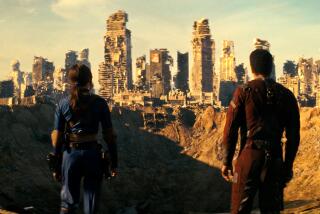Thou shalt not forget DeMille set
- Share via
It sounds like a classic film, but DeMille’s Lost City is a crusade aimed at recovering the massive film sets that Cecil B. DeMille buried in 1923 after shooting the silent film “The Ten Commandments.”
Peter Brosnan and some friends got involved with the Lost City Project after a 1984 storm revealed portions of the set amid the giant dunes near Guadalupe in northern Santa Barbara County.
“It’s important for film history and one hell of a fun project,” says Brosnan, a clinical psychotherapist, longtime screenwriter and project director for the Lost City. “It’s the last of the great sets from the 1920s. DeMille was on the dunes with thousands of extras for several months with Paul Iribe, the father of Art Deco, who raised set design to the level of an art form.”
A team of archaeologists and volunteers surveyed the site in 1990 using ground-penetrating radar and determined a majority of the sets were still intact, including 12 sphinxes that weigh 5 tons each.
DeMille, who re-made “The Ten Commandments” starring Charlton Heston in 1956, buried the sets for budgetary reasons and to prevent renegade filmmakers from re-using them, Brosnan says.
Artifacts already from the site -- tobacco tins, cough medicine bottles and remnants of costumes -- are displayed at the nearby Dunes Center in Guadalupe. The Lost City recovery effort has raised about $25,000 and, with a matching offer from the DeMille family, hopes to collect more, Brosnan says.
“It is kind of a real-life ‘Indiana Jones.’ We’re digging up an ancient Egyptian city in California and it gives the project a lot of whimsy and charm. We saved so little from the silent era. It’s a tangible piece. It needs to be saved.”
More to Read
Only good movies
Get the Indie Focus newsletter, Mark Olsen's weekly guide to the world of cinema.
You may occasionally receive promotional content from the Los Angeles Times.







